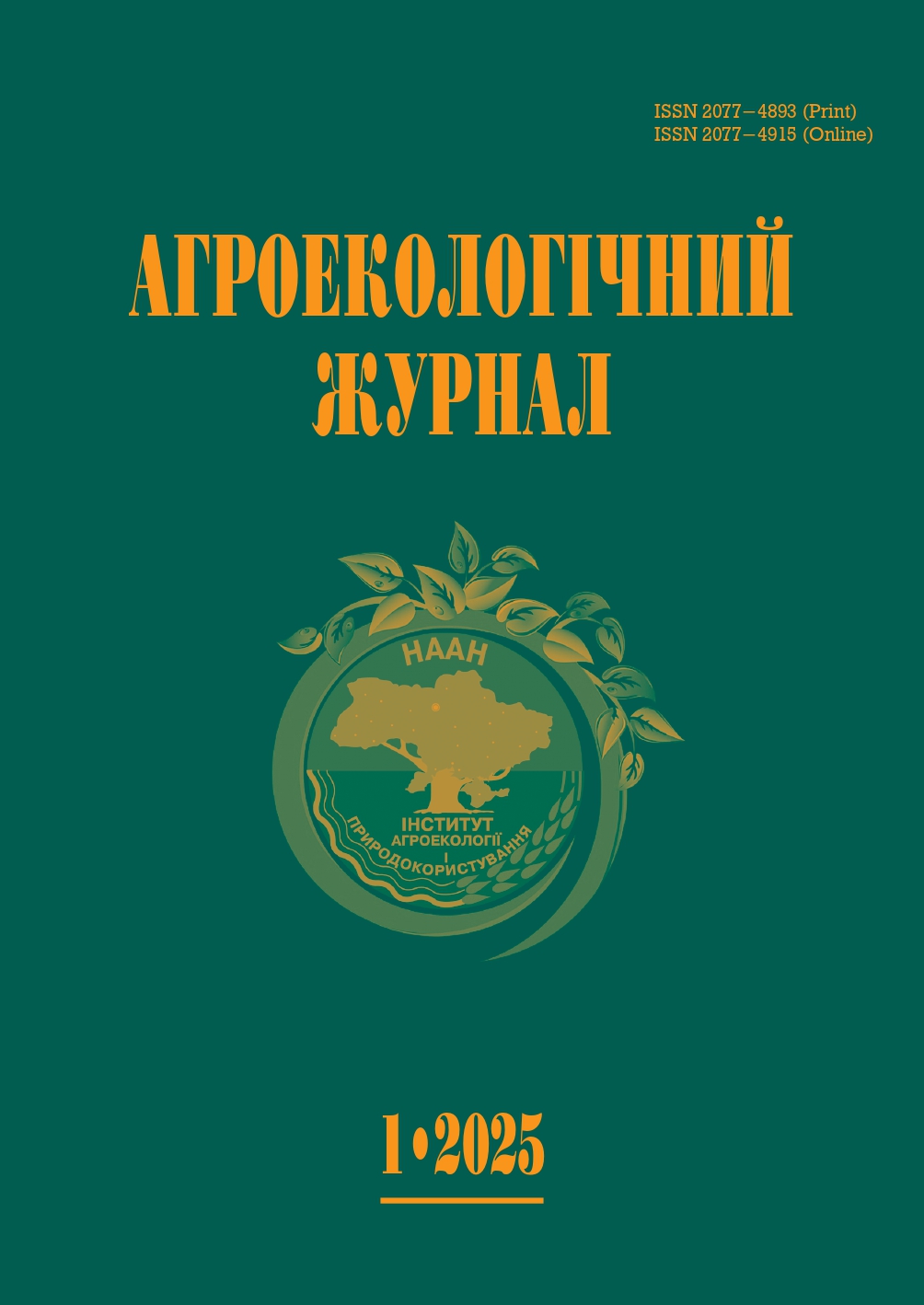Активовані саліцилатом зміни показників посухостійкості рослин пшениці (Triticum aestivum L.)
DOI:
https://doi.org/10.33730/2077-4893.1.2025.327102Ключові слова:
дефіцит вологи, саліцилова кислота, стресові чинники, стійкість, пролін, вільні амінокислотиАнотація
У зв’язку із глобальними змінами клімату посуха є одним із найрозповсюдженіших стресових чинників для більшості біологічних видів. Підвищення стійкості сільськогосподарських культур до дії цього стресора дасть можливість істотно збільшити їх продуктивність. Саліцилова кислота — біологічно активна сполука фенольної природи з поліфункціональними властивостями, яка бере участь у формуванні стійкості рослин на дію чинників біотичної та абіотичної природи. Зважаючи на актуальність дослідження сполук, які мають стрес-протекторні властивості, метою роботи було вивчити вплив обробки насіння саліциловою кислотою на вміст води, проліну, вільних амінокислот і посухостійкість рослин пшениці (Triticum aestivum L.) сорту Подолянка в модельних умовах посухи. Встановлено, що за дефіциту вологи відбувається зменшення вмісту води в органах пшениці. Обробка насіння саліциловою кислотою підвищує вміст води у коренях на 7%, а у пагонах — на 6%, а також майже вдвічі збільшує вміст проліну в рослинних тканинах щодо контролю. Натомість за дефіциту вологи встановлено зростання вмісту вільних амінокислот в органах пшениці на 20–30% щодо контролю. За сумісного впливу саліцилату і стресового чинника вміст цих метаболітів істотно збільшувався, що свідчить про активацію захисних реакцій рослин. Визначення посухостійкості рослин за вмістом статолітного крохмалю вказує на низьку посухостійкість досліджуваного сорту пшениці Подолянка. Дія саліцилової кислоти зумовила зростання посухостійкості рослин. Отже, саліцилову кислоту можна розглядати як сполуку, яка позитивно впливає на метаболізм рослин пшениці, активуючи нагромадження таких стрес-протекторних сполук, як пролін та вільні амінокислоти. Крім того, ця сполука підвищує оводнення тканин і посухостійкість рослин. Результати досліджень дають можливість рекомендувати саліцилову кислоту як сполуку, яка підвищує стійкість рослин до нестачі вологи.
Посилання
Waadt, R., Seller, C. A., Hsu, P. K., Takahashi, Y., Munemasa, S., & Schroeder, J. I. (2022). Plant hormone regulation of abiotic stress responses. Nat. Rev. Mol. Cell. Biol., 23(10), 680–694. DOI: https://doi.org/10.1038/s41580-022-00479-6.
Song, W., Shao, H., Zheng, A., Zhao, L., & Xu, Y. (2023). Advances in roles of salicylic acid in plant tolerance responses to biotic and abiotic stresses. Plants (Basel), 12(19), 3475. DOI: https://doi.org/10.3390/plants12193475.
Кавулич, Я., Кобилецька, M., Романюк, Н., & Терек, O. (2023). Стрес-протекторні і регуляторні властивості саліцилової кислоти і перспективи її застосування у рослинництві. Біологічні студії, 17(2), 173–200. DOI: https://doi.org/ 10.30970/sbi.1702.718.
Kobyletska, M., & Kavulych, Y. (2024). The effect of salicylic acid on the content of ascorbic acid and phenolic compounds in wheat plants. Studia Biologica, 18(2), 125–137. DOI: https://doi.org/10.30970/sbi.1802.778.
Castañeda, V., & González, E. M. (2021). Strategies to apply water-deficit stress: similarities and disparities at the whole plant metabolism level in Medicago truncatula. International Journal of Molecular Sciences, 22(6), 2813. DOI: https://doi.org/10.3390/ijms22062813.
Živanović, B., Milić Komić, S., Tosti T., Vidović, M., Prokić, L., & Veljović Jovanović, S. (2020). Leaf soluble sugars and free amino acids as important components of abscisic acid-mediated drought response in tomato. Plants (Basel), 9(9), 1147. DOI: https://doi.org/10.3390/plants9091147.
Kapoor, D., Bhardwaj, S., Landi, M., Sharma, A., Ramakrishnan, M., & Sharma, A. (2020). The impact of drought in plant metabolism: how to exploit tolerance mechanisms to increase crop production. Applied Sciences, 10(16), 5692. DOI: https://doi.org/10.3390/app10165692.
Fàbregas, N., & Fernie, A. R. (2019). The metabolic response to drought. Journal of Experimental Botany, 70(4), 1077–1085. DOI: https://doi.org/10.1093/jxb/ery437.
Barroso Neto, J., Silva, J. R. I., Bezerra, C.W.F., Amorim, T. L., Hermínio, P. J., Morato, R. P., Albuquerque-Silva, M. M., & Simões, V. J. L. P. (2021). Drought and climate change impacts on plant metabolism: A review. Research, Society and Development, 10(8), e16710817060. DOI: https://doi.org/10.33448/rsd-v10i8.17060.
Oguz, M. C., Aycan, M., Oguz, E., Poyraz, I., & Yildiz, M. (2022). Drought stress tolerance in plants: interplay of molecular, biochemical and physiological responses in important development stages. Physiologia, 2(4), 180–197. DOI: https://doi.org/10.3390/physiologia2040015.
Ding, Y., Fan, B., Zhu, C., & Chen, Z. (2023). Shared and related molecular targets and actions of salicylic acid in plants and humans. Cells, 12(2), 219. DOI: https://doi.org/10.3390/cells12020219.
Rahmani, N., & Radjabian, T. (2024). Integrative effects of phytohormones in the phenolic acids production in Salvia verticillata L. under multi-walled carbon nanotubes and methyl jasmonate elicitation. BMC Plant Biol., 24, 56. DOI: https://doi.org/10.1186/s12870-023-04719-5.
Sytar, O., Zivcak, M., Konate, K., & Brestic, M. (2022). Phenolic acid patterns in different plant species of families Asteraceae and Lamiaceae: possible phylogenetic relationships and potential molecular markers. Journal of Chemistry, 9632979. DOI: https://doi.org/10.1155/2022/9632979.
Pratyusha, S. (2022). Phenolic compounds in the plant development and defense: an overview. IntechOpen. DOI: https://doi.org/10.5772/intechopen.102873.
Колупаєв, Ю. Є., Ястреб, T. O., Шкляревський, M. A., Карпець, Ю. В., & Дяченко, A. I. (2021). Саліцилова кислота: синтез і стрес-протекторний ефект у рослинах. Вісник Харківського національного аграрного університету. Сер.: «Біологія», 2(53), 6–22. DOI: https://doi.org/10.35550/vbio2021.02.006.
Xin, K., Wu, Y., Ikram, A. U., Jing, Y., Liu, S., Zhang, Y., & Chen, J. (2025). Salicylic acid cooperates with different small molecules to control biotic and abiotic stress responses. Journal of plant physiology, 304, 154406. DOI: https://doi.org/10.1016/j.jplph.2024.154406.
Elsisi, M., Elshiekh, M., Sabry, N., Aziz, M., Attia, K., Islam, F., Chen, J., & Abdelrahman, M. (2024). The genetic orchestra of salicylic acid in plant resilience to climate change induced abiotic stress: critical review. Stress Biology, 4, 31. DOI: https://doi.org/10.1007/s44154-024-00160-2.
Ievinsh, G. (2023). Water content of plant tissues: so simple that almost forgotten? Plants, 12(6), 1238. DOI: https://doi.org/10.3390/plants12061238.
Bates, L. S., Waldren, R. P., & Teare, I. D. (1973). Rapid determination of free proline for water-stress studies. Plant and Soil, 39, 205–207. DOI: https://doi.org/10.1007/BF00018060.
Xiong, Z.-Т., Liu, С., & Geng, В. (2006). Phytotoxic effects of соррег оn nitrogen metabolism and plant growth in Brassica pekinsis Rupr. Ecotoxiology and Enviromental Safety, 64, 273–280. DOI: https://doi.org/10.1016/j.ecoenv.2006.02.003.
Пикало, С., Демидов, O., Юрченко, T., Хоменко, С., Гуменюк, O., Харченко, M., & Прокопік, Н. (2020). Методи оцінки посухостійкості селекційного матеріалу пшениці. Вісник Львівського університету. Сер.: біологічна, 82, 63–79. DOI: https://doi.org/10.30970/vlubs.2020.82.05.
Guo, S., Ma, X., Cai, W., Wang, Y., Gao, X., Fu, B., & Li, S. (2022). Exogenous proline improves salt tolerance of Alfalfa through modulation of antioxidant capacity, ion homeostasis, and proline metabolism. Plants, 11(21), 2994. DOI: https://doi.org/10.3390/plants11212994.
Trovato, M., Funck, D., Forlani, G., Okumoto, S., & Amir, R. (2021). Editorial: amino acids in plants: regulation and functions in development and stress defense. Frontiers in plant science, 12, 772810. DOI: https://doi.org/10.3389/fpls.2021.772810.
Demyanyuk, O., Oliinyk, K., Davydiuk, H., Yula, V., Shatkovska, K., & Mostovıak, I. (2023). Productivity of winter wheat under cultivation technologies of different intensity. Zemdirbyste–Agriculture, 110(2), 3–14. DOI: https://doi.org/10.13080/z-a.2023.110.013.
Tyshchenko, A., Tyshchenko, O., Konovalova, V., Fundirat, K., & Piliarska, O. (2023). Methods of determining the drought resistance of plants. Scientific Collection «InterConf+», 33(155), 343–361. DOI: https://doi.org/10.51582/interconf.19-20.05.2023.030.
##submission.downloads##
Опубліковано
Номер
Розділ
Ліцензія

Ця робота ліцензується відповідно до Creative Commons Attribution 4.0 International License.
Авторське право і ліцензування
Умови ліцензії: автори зберігають авторські права і надають журналу право першої публікації з роботою, одночасно ліцензованої за ліцензією Creative Commons Attribution License International CC-BY, яка дозволяє іншим ділитися роботою з визнанням авторства роботи і початкової публікації в цьому журналі.
Якщо стаття прийнята до публікації в «Агроекологічний журнал», автор повинен підписати угоду про передачу авторських прав. Угода відправляється на поштову (оригінал) або адресу електронної пошти (відсканована копія) редакції журналу.
Цією угодою автор підтверджує, що представлені матеріали:
- не порушують авторських прав інших осіб або організацій;
- раніше не публікувались в інших видавництвах і не були представлені для публікації в інших виданнях.
Автор передає редакції «Агроекологічного журналу» права на:
- публікації статті українською (англійською) мовою і поширення її друкованої копії;
- поширення електронної копії статті, а також електронної копії перекладу статті на англійську мову (для статей українською мовою), будь-якими електронними засобами (розміщення на офіційному сайті журналу, електронних баз даних, сховищ тощо) друкована копія перекладу.
Автор залишає за собою право без згоди редакції та засновників:
- Використовувати матеріали статті повністю або частково в ознайомлювальних цілях.
- Використовувати матеріали статті повністю або частково для написання власних дисертацій.
- Використовувати матеріали статті для підготовки тез доповідей, доповідей конференцій, а також усних доповідей.
- Додати електронні копії статті (включаючи остаточну електронну копію, завантажену з офіційного сайту журналу) за адресою:
- персональні веб-ресурси всіх авторів (веб-сайти, веб-сторінки, блоги тощо);
- веб-ресурси установ, в яких працюють автори;
- некомерційні веб-ресурси відкритого доступу (наприклад, arXiv.org).
У всіх випадках наявність бібліографічного посилання на статтю або гіперпосилання на її електронну копію на офіційному сайті журналу є обов'язковим.



